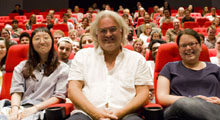
“Ultimately, you need to see what the film should be and go towards that with absolute conviction”
Four time BAFTA winning and Oscar nominated writer-director Paul Greengrass dropped in for a fascinating masterclass at the NFTS and regaled the students with tales of his journey from making hard-hitting documentary series for British investigative current affairs programme, World in Action, to award-winning feature films that bear his distinctive docurealistic style.
His acclaimed work includes United 93, The Bourne Supremacy, The Bourne Ultimatum, Bloody Sunday, The Murder of Stephen Lawrence, Omagh and Captain Phillips. His BAFTAs include an award for Outstanding Contribution to Television.
The session was hosted by NFTS Director, Nik Powell, who kicked things off by selecting a clip of Paul’s first feature film, Resurrected. Resurrected is the true story of a British soldier, Philip Williams (played by David Thewlis), who is presumed dead and left behind in the Falklands but is accused of desertion when he reappears seven weeks after the war ends.

(Nik Powell, former NFTS Director & Paul Greengrass)
According to Paul, “Granada, which made World in Action, gave me a great film education. The World in Action title was actually bought from (pioneering Scottish documentary maker), John Grierson and had its roots in documentary realism. I was taught to shoot like that.” Paul learnt from the likes of seasoned broadcaster, John Slater, who incidentally taught at the NFTS in the 1970s and is described in The Guardian’s Obituary report as ‘nurturing a generation’ while ‘retaining his radical roots.’ Paul said: “John was a complete maniac, but I loved him! I learned from him that the moving picture has its own life but if you allow it to spew everywhere, it has no form. Knowing how to engage with that paradox is the essence of filmmaking. You have to listen to where the film wants to go but also be the master of it. World In Action gave me a language. The challenge for me was staying with that aesthetic and building in a fictional camera. Even when I made Bourne, I tried to use that language through employing a ‘knowing’ and an ‘unknowing’ camera.”

While Paul was at Granada, he developed a desire to make movies and move into feature films. He came up with the idea for Resurrection and felt “it was a story that spoke to Britain at that time. When I met David Thewlis who stars in Resurrection, it was the first time I met an actor!” Paul said: “I was advised at the time to never treat actors like human marionettes. Your relationship with actors is the most important bond you have when making a film. When you make a film, you’re in a box. It doesn’t matter if it’s a student film or a big movie, there’s always a box or set of restrictions whether it’s resources, practicality, space or time. Everyone can solve certain problems but it’s the actor who is the one person in the equation that can solve all problems in a heartbeat.”

Paul gave an incredible example to illustrate this when he was shooting a scene in Captain Philips that just wouldn’t go right. “After shooting it every f****** way possible, we had a conversation with the captain of the ship, who advised that Tom Hanks’ character would have gone to the medics room after being rescued covered in blood. We used the ship’s actual medic in the scene who stepped in brilliantly despite being in awe of Tom Hanks. Something happened and you could feel the intensity as you were shooting it. Great actors are like water diviners, they know where the truth is!”
It took Paul a while to build the confidence to walk away from a project he knew wasn’t right. He said: “Ultimately, you need to see what the film should be and go towards that with absolute conviction and have an unwavering desire to control it. Nothing must deflect you from that. If you’re going to make films successfully, you have to develop an inner core that says, don’t f*** me around but you can’t develop that by starting off with f*** me arrogance. You need to listen and ask, what do you think? You won’t develop the character or muscles to make your point of view prevail if you don’t collaborate and work with people.”

After a clip of Bloody Sunday about the 1972 "Bloody Sunday" shootings in Derry, Northern Ireland, Nik asked Paul about the techniques he used such as fading to black in between shots. Paul explained: “I wanted to convey how events spiralled into each other like a macabre violent ballet. Bloody Sunday was cut beautifully by Clare Douglas; the fade to black gave it an energy and clarity and a sense of almost watching strobing images, creating a rhythm”.

Paul employed the same sense of docurealism when making United 93, which chronicles events on United Airlines Flight 93 when it was hijacked during the September 11 attacks. “We decided from the outset that we would shoot entirely in the aeroplane and so be bound by the physical space and real time experience. We had the camera on a bungee which gave a sense of tremendous fluidity married with realism in the confined space. It was an incredibly inspiring filmmaking experience. It felt like we were telling the truth about it.”
If you would like to attend masterclasses like this one, applications are open for a range of MA and Diploma courses from our Digital Effects MA to our Diploma in Production Accounting– for the full list of courses starting in January 2018, click here.
